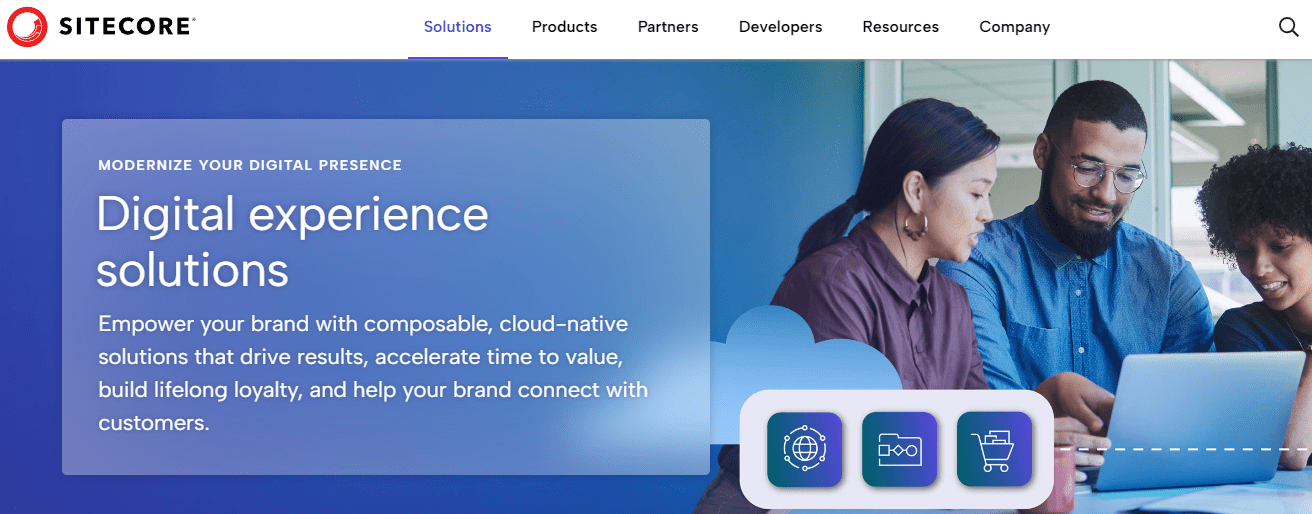5 Enterprise-Level Alternatives to Adobe Experience Manager
Explore five powerful enterprise-level alternatives to Adobe Experience Manager for enhanced digital experience management

Table of Contents
Adobe is a market leader in enterprise-level Content Management Systems (CMS). Adobe Experience Manager (AEM) helps many global companies store, organize, and manage online content. However, for many businesses, especially large enterprises, AEM often has drawbacks. High costs, a dependency on developers for minor changes, and limited customization options can present significant challenges.
Thankfully, AEM isn’t the only option. There are many other CMS solutions suitable for large enterprises. In this article, we'll explore the pros and cons of AEM and consider the top five alternatives to this CMS.
Whether you want enhanced customization, cost-effectiveness, or improved workflows, this guide will help you discover the best CMS for your business
Pros and Cons of Adobe Experience Manager
Pros of AEM
Scalability: AEM is great for scalability and adept at handling vast amounts of data and traffic. Even if your business experiences a surge in website visitors or manages an extensive library of digital assets, AEM ensures performance and reliability are never compromised.
Personalization: Using sophisticated AI-driven tools, AEM offers personalized customer experiences. Through advanced segmentation and targeting, businesses can deliver content tailored to individual users, enhancing engagement and driving conversions.
Multichannel Content Management: Whether it’s for web, mobile, social media, or email, AEM provides a unified platform for content creation, management, and distribution, ensuring a cohesive brand experience.
Customer Support: AEM offers its users dedicated support teams and comprehensive documentation to resolve any issues or challenges they may encounter.
Cons of AEM
High Cost: One of AEM’s primary drawbacks is its cost. The investment required for licensing and implementing AEM can be substantial, particularly for enterprises operating on constrained budgets.
Complexity: AEM is renowned for its feature set and extensive capabilities. However, navigating them can be daunting, especially for team members without AEM experience. The steep learning curve associated with AEM implementation can pose challenges and hinder productivity.
Dependency on Developers: Relying on dedicated teams of developers for maintenance and updates means AEM can lead to bottlenecks in the development process, resulting in longer deployment times for content and features. Businesses may incur additional costs associated with developer resources, adding to the overall investment in AEM implementation.
Businesses should carefully consider their requirements and priorities when considering AEM for their content management. While AEM offers scalability and personalization opportunities, its high cost and complexity may present barriers for some organizations.
Exploring Alternatives to Adobe Experience Manager
WordPress

WordPress is by far the most popular CMS, powering 43.3% of websites online. This popularity is largely due to its ease of use, making it a favorite among large organizations. With WordPress, multiple teams can quickly upload content, freeing developers' time to focus on other aspects or projects. This agility is especially beneficial for fast-paced industries like media and publishing.
Here at Multidots, we choose to build sites using WordPress. Why? For one, because of the sheer volume of customization options. No matter what size site you want to build or what functionality you need, WordPress can cater to it all.

WordPress has extensive integration capabilities with digital tools and Customer Relationship Management (CRM) systems, creating a flexible system adaptable to any industry. Its collection of plugins and themes enables organizations to customize their sites to their unique specifications.
Something else that truly sets WordPress apart is its community support, which provides users with a wealth of resources and assistance. As an open-source CMS, WordPress allows users to view and modify its source code, ensuring full ownership of their software and content without being tied down by licensing fees. This openness also translates to cost-effectiveness, making WordPress an attractive option for enterprises of all sizes.
Some great things to know about WordPress are:
- It is open source.
- There are over 55,000 plugins to bring your vision to life.
- You can choose your website layout from thousands of themes or start from scratch.
- WordPress has worked with big names like NASA and Rolling Stone.
- You own all of your content.
Drupal

Like WordPress, Drupal is an open-source CMS that benefits from transparency, flexibility, and community-driven development. What people like most about Drupal is its philosophy of catering to "ambitious site builders" who aspire to create sophisticated and highly extensible websites.
For enterprises with large digital initiatives, Drupal offers extensive customization capabilities. Its modular system allows developers to craft tailored solutions, ensuring the CMS aligns perfectly with the organization's unique requirements and objectives.
However, it's important to recognize that not every enterprise necessarily requires an ambitious build. Sometimes, prioritizing speed and ease of use may be more important over extensive customization. While Drupal is great for ambitious projects, organizations should weigh the trade-offs and consider their specific needs and priorities.
Some things to know about Drupal:
- It is open source.
- It has translation capabilities.
- It offers real-time sales alerts with marketing automation.
Liferay

Liferay is known for its capability to craft portals, intranets, and extranets, making it a good option for organizations looking for more comprehensive solutions.
With Liferay, organizations can integrate various web applications, including websites, mobile app development platforms, Enterprise Resource Management (ERM) software, and customer databases. This integration helps to create a cohesive digital ecosystem, improving operations and enhancing user experiences across multiple channels.
However, Liferay's extensive features come with a steep learning curve. While it offers powerful capabilities for organizations with complex digital needs, mastering the platform may require significant time and resources. Organizations considering Liferay must be prepared to invest in training and support to use its potential fully.
Some things to know about Liferay:
- It is used by over 1,200 customers worldwide.
- It offers the flexibility to replace or incorporate any technologies with composable architecture, including your current systems and tools.
Sitecore

Sitecore combines content management, commerce, marketing automation, and personalization into integrated software. This approach allows organizations to deliver tailored and engaging experiences across all digital touchpoints, driving customer engagement and loyalty.
With its foundation built on the .NET framework, Sitecore is particularly appealing to developers already familiar with this technology stack. This familiarity allows for efficient development and customization, using the platform's full potential to meet specific business needs and objectives.
However, like Liferay, Sitecore's extensive feature set and capabilities may be challenging for users unfamiliar with the platform. It can be difficult to learn, and it takes quite a lot of time to get used to everything. While Sitecore offers excellent functionality for organizations looking for a unified online experience, careful consideration and investment in training are essential to maximizing its benefits!
Some things to know about Sitecore:
- Over 3,000 companies are using Sitecore.
- It offers many personalization features.
- Real-time brand management is also available with Sitecore.
Joomla

Joomla is especially popular due to its multilingual capabilities, making it an excellent choice for organizations with diverse audiences in different languages and regions. Its built-in features and extensions facilitate seamless translation and localization, enabling businesses to reach a global audience effectively.
Joomla is known for its user-friendly nature, offering a more intuitive and straightforward content management experience. From customizable templates to a library of extensions, Joomla provides flexibility in design and functionality, ensuring that each website reflects the unique identity and branding of the organization.
While Joomla is suitable for organizations of all sizes, it is often considered more ideal for medium enterprises than large corporations. Its user-friendly nature and customization capabilities make it well-suited for businesses looking for a cost-effective solution with robust features, scalability, and ease of use.
Some things to know about Joomla:
- Joomla is mobile-friendly.
- It offers unlimited design options.
- It has multi-user permission levels for added security.
Seamless Migration to WordPress With Multidots Expertise
Numerous options exist for enterprises looking for a change. However, with so many to choose from, which one comes out on top?
Looking closely at the options, WordPress is clearly the most effective CMS for every business, no matter the size. WordPress is open source, powerful, and highly customizable, not to mention that it has thousands of experts within one community.
If you’re worried about migrating your site to WordPress, don’t! Multidots is a leading WordPress development agency specializing in enterprise migrations. With our expertise, migrating from AEM to WordPress is easy without data loss and downtime.
Most importantly, the Multidots approach ensures that each migration is handled with precision and care, guaranteeing a smooth transition to WordPress. Our team has contributed nearly 14,000 hours of time to the WordPress community, and we know everything about enterprise-level migrations, making us the ideal partner for organizations looking to move to WordPress.
If you're considering a switch to WordPress and want to explore why it's the best option for your enterprise, contact Multidots today!
Feel free to schedule a quick call with our migration expert.
Contact Us